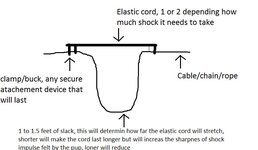GSD_Knot_Lover
Tourist
Does anyone have any tips on how to train a dog not to run to the end of the tether and basically clothesline himself?
I just recently picked up a dog from someone and he is not very well trained. I have training classes scheduled, but in the meantime, we are just working on the very basics like sit, lay down, etc. He is a Saint Bernard mix, a bit over a year old, and over 120 lbs. His previous owner had a fenced-in yard so he never had to be on a tether. The first time I tried as soon as I unclipped the leash he took off and almost hurt himself when he hit the end of the tether. I really don't want him to hurt himself so I've been taking him out on a leash now, but if it's raining hard or just bad weather I would like to be able to just clip him to the tether so he can do his business. He doesn't seem interested in doing his business in the yard either, only while we are on walks. Maybe that's because he wants to explore this new area? Any tips/advice is greatly appreciated.
I just recently picked up a dog from someone and he is not very well trained. I have training classes scheduled, but in the meantime, we are just working on the very basics like sit, lay down, etc. He is a Saint Bernard mix, a bit over a year old, and over 120 lbs. His previous owner had a fenced-in yard so he never had to be on a tether. The first time I tried as soon as I unclipped the leash he took off and almost hurt himself when he hit the end of the tether. I really don't want him to hurt himself so I've been taking him out on a leash now, but if it's raining hard or just bad weather I would like to be able to just clip him to the tether so he can do his business. He doesn't seem interested in doing his business in the yard either, only while we are on walks. Maybe that's because he wants to explore this new area? Any tips/advice is greatly appreciated.


